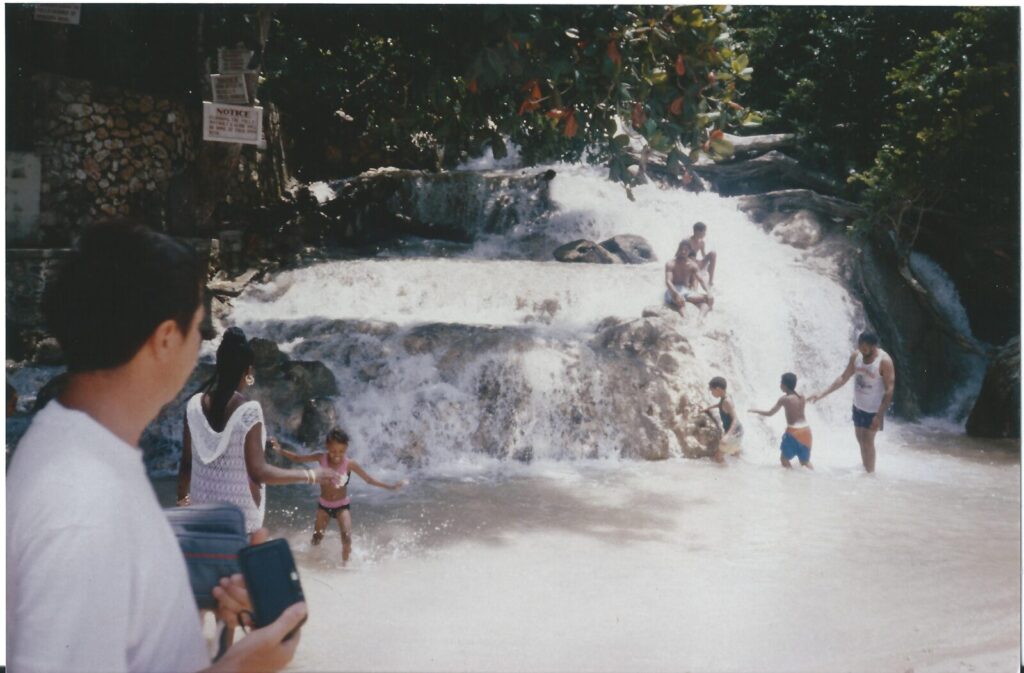
Sunday 26th June was one hell of a storm…..all diving cancelled and nothing to do but write up log-books and prepare to transfer to the final dive area at Discovery Bay, where we would be hosted by the University of the West Indies, using their facility, The Discovery Bay Marine Laboratory (DBML) at Mona, an hour out of Montego Bay. The DBML had been around since its founding in 1965, by Professor Thomas F Goreau, dedicated to marine Biology, Research, Geology and Coral Reef Study, it was founded on land donated by the Kaiser Bauxite Company and funded by the Wolfson Foundation & CIDA. Professor Goreau was based out of Stonybrook University (New York), and DBML was a joint venture with SU(NY) until 1975, when the University of the West Indies took sole ownership and eventually founded the Centre for Marine Sciences (CMS) in 1990
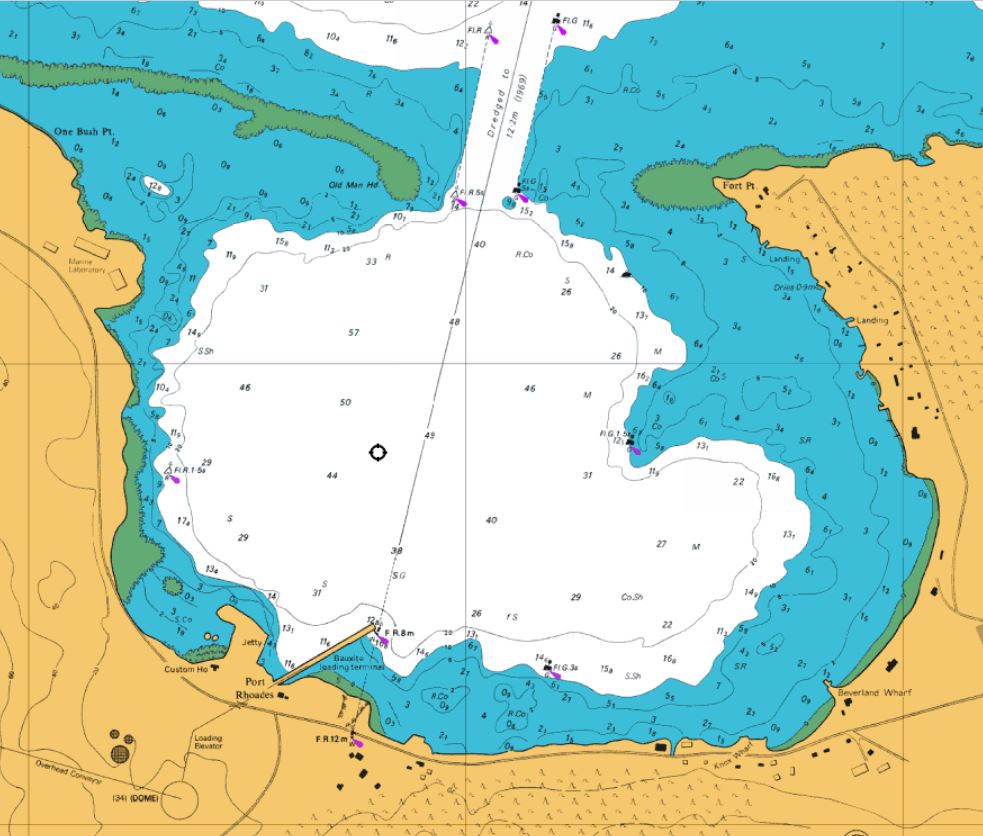
Don had pulled another blinder, this was a great location, with on-site accommodation blocks, a wealth of knowledge of the diving in the area, and their own boats. It looked like we were in for another great week’s diving! We settled into our bunk-house, a two storey block segregated into bunk rooms, and got out our kit for checking and a bit of prep
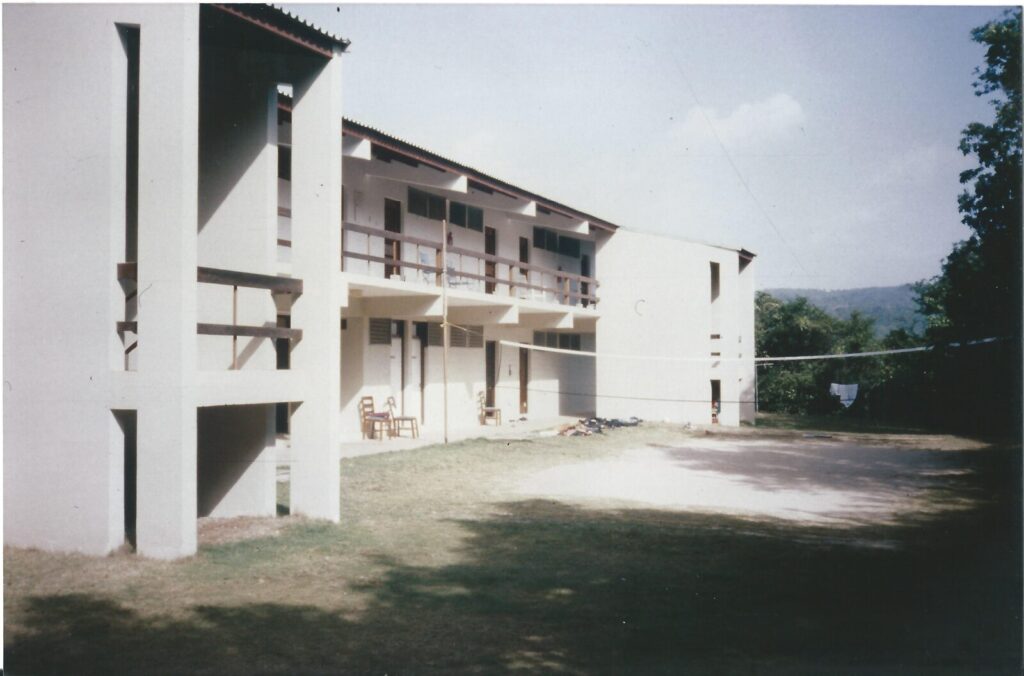
The rooms were 4 man bunk affairs and comfy enough but with little, if any, air-conditioning, it made for hot, restless, sleep deprived nights, there were decent kitchen facilities in the main building and apart from the odd electrical “outage” things were pretty decent. The rooms were plagued by Mosquito’s, but we had nets and bought coils of noxious substances to keep as many out as we could, and they worked….of a fashion
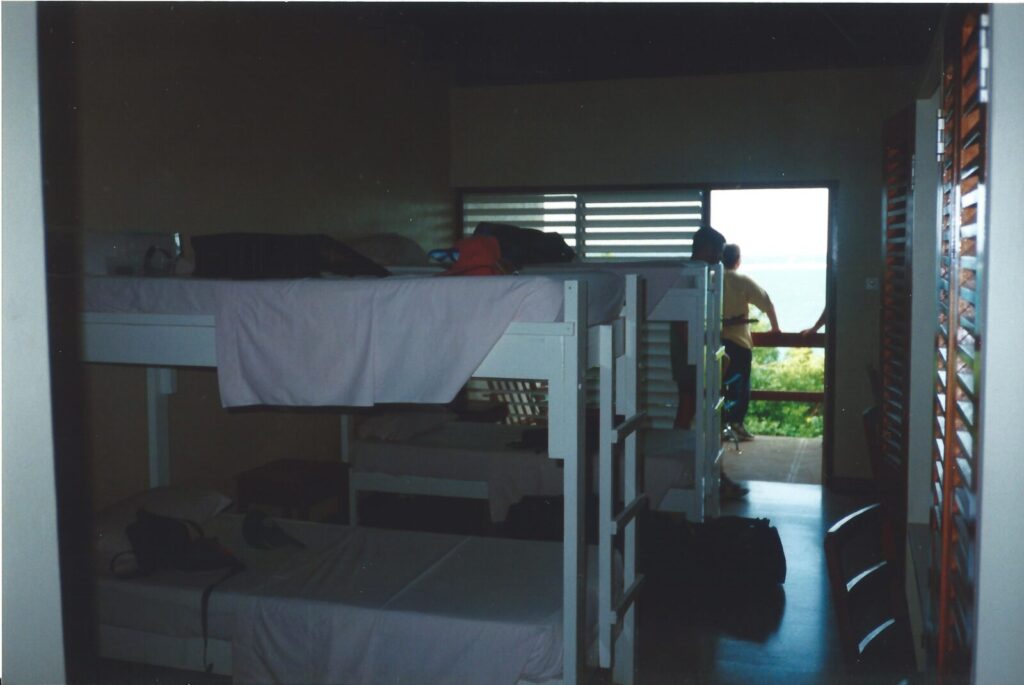
Our first dive, after we had serviced the boat engines and cleaned the plugs and filters, was just around the headland to one of the University study sites on a local reef, my log book says: “…..Small boat dive – Discovery Bay (JA) Down to 21m and a guided tour round a reef, plenty of small fish about in bright coloured shoals and a visit to the university pens full of Lobster & a huge Crab…Air In 210 out 100 W/Temp 28’ Buddy John…” I liked the reef, immediately in front of the DBML quay, it was made of large outcrops with White sand between, like islands if you will, surrounded by Powder Blue of the Caribbean Sea, easy and beautiful diving, a pleasure to be in. Not bad for what was, essentially, a check-out dive by the university, who had been quite adamant that our diver cox’s should prove their skills before we were allowed to take the boats out ourselves and do some exploring!

Our next dive out of the local bay was out to the main reef, the reef fringes Jamaica’s entire North coast, being almost continuous its entire length. It runs across the bay front, separating it from the open sea, starting around 300m from DBML, which is on the bay’s West side as you can see from the Admiralty Chart at the beginning of this piece. In fact you can see the reef in the shot above, just behind the Skiffs, most obvious slightly beyond the rock outcrop. This dive, we had decided, would be on the outer, seaward side of the reef, a little more adventurous, given that the reef wall descends to 200m plus not far from the reef itself, the dive log entry for June 28th ‘94: “….Small Boat Dive – Discovery Bay (JA) Freefall past a reef @20m going down to who knows how deep then back up to the 15m mark and along gullies full of life, caught sight of a large Ray but couldn’t I.D it found a Spotted Moray in a hide and had a 10 min stay at a great coral head full of Snappers and Yellowtails Air in 210 out 75 W/Temp 28’ Buddy’s Don & Rob”
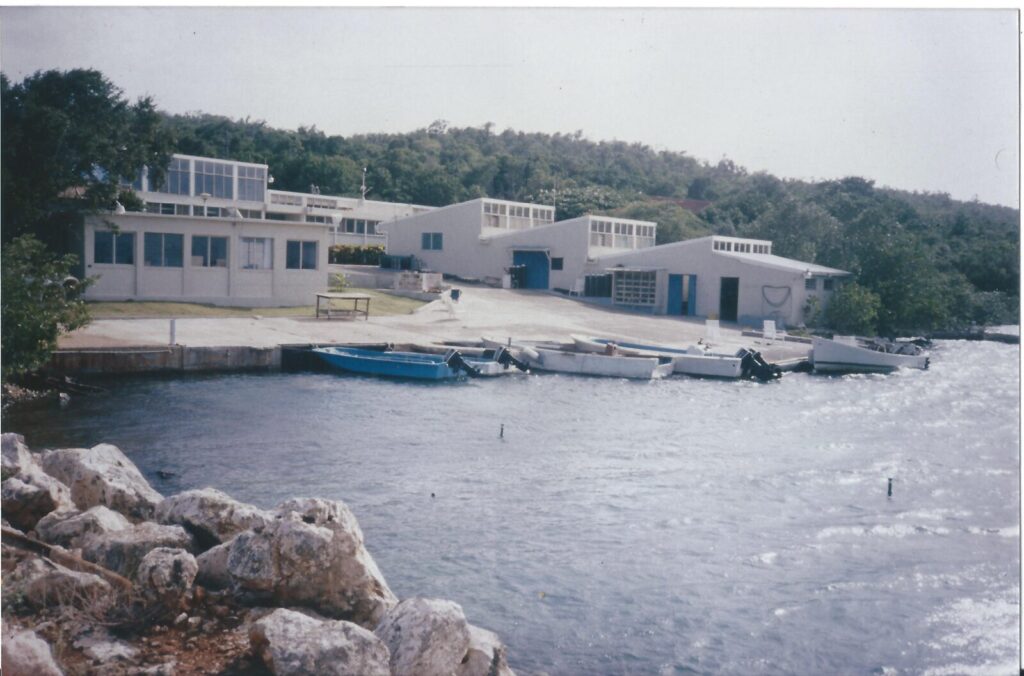
The geology of the area is predominantly Limestone, there are popular caves (The Green Grotto), which are tourist traps, locally, and the area is essentially a Karst type environment, as described here: (Bonem R.M: “Effects of Submarine Karst Development on Reef Succession”. In: Proceedings of the 6th International Coral Reef Symposium, Australia, 1988, Vol.3) where, in the abstract (introduction) Bonem states: “The geomorphic configuration of the limestone substrate commonly has been modified by one or more phases of subaerial karst development prior to submergence.” And goes on to quote: “Discovery Bay, located on the north coast of Jamaica between Montego Bay and St. Ann’s Bay (figure 1). has been a centre for reef studies since the late 1960’s. According to Woodley & Robinson (1977, p. 18), Discovery Bay has been described as a “drowned river valley excavated by solution, which has been partly cut off from the sea by recent reef growth.” The bay is a circular, saucer-like depression with a maximum depth of -53 metres. A submerged collapse doline (sinkhole) occurs in the northwest corner of the shallow shelf that restricts the bay. A fault, trending approximately N. 40′ E., can be traced from land into the bay, cutting the shallow shelf and displacing the east forereef -10 metres relative to the west forereef (Liddell & Ohlhorst 1981).”
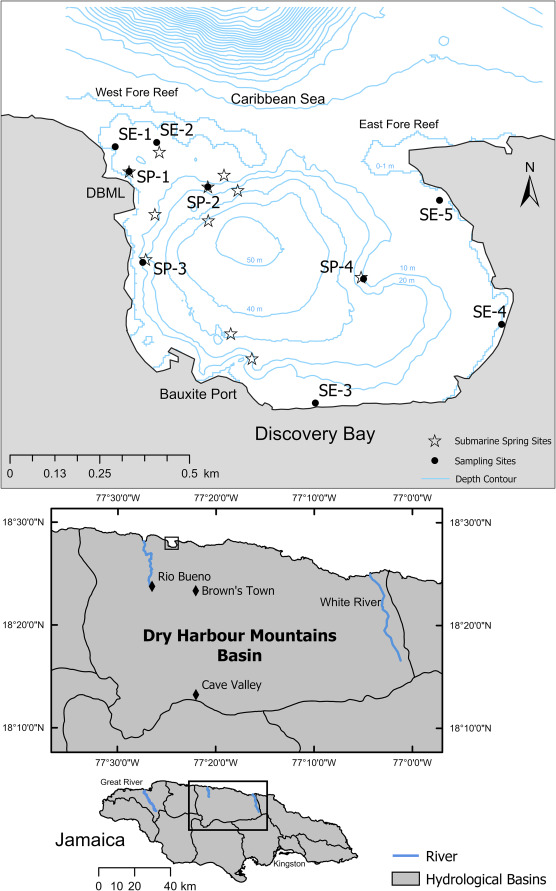
Our next dive went looking for the evidence of the fault mentioned, a source of fresh water permeating into the sea in the form of underwater haloclines, areas of distinct visual disturbances where salt and fresh water mix and end up in layers of different salinities with different refraction indexes…..we weren’t disappointed either, my log records: “…Small Boat Dive – Discovery Bay (JA) Down to 16.6m Viz down to 2m due to the fresh water springs in the area Right of the marine lab Still eerie at the thermocline everything cloaked in mist – good dive still….” It sounds like I’m defending myself here, the “thermocline” existed too, it was distinctly cooler where the fresh water springs entered the sea, so you had the effect of both salinity drop and temperature drop…..it was a cool dive but not my first in such a distinct visual paradox
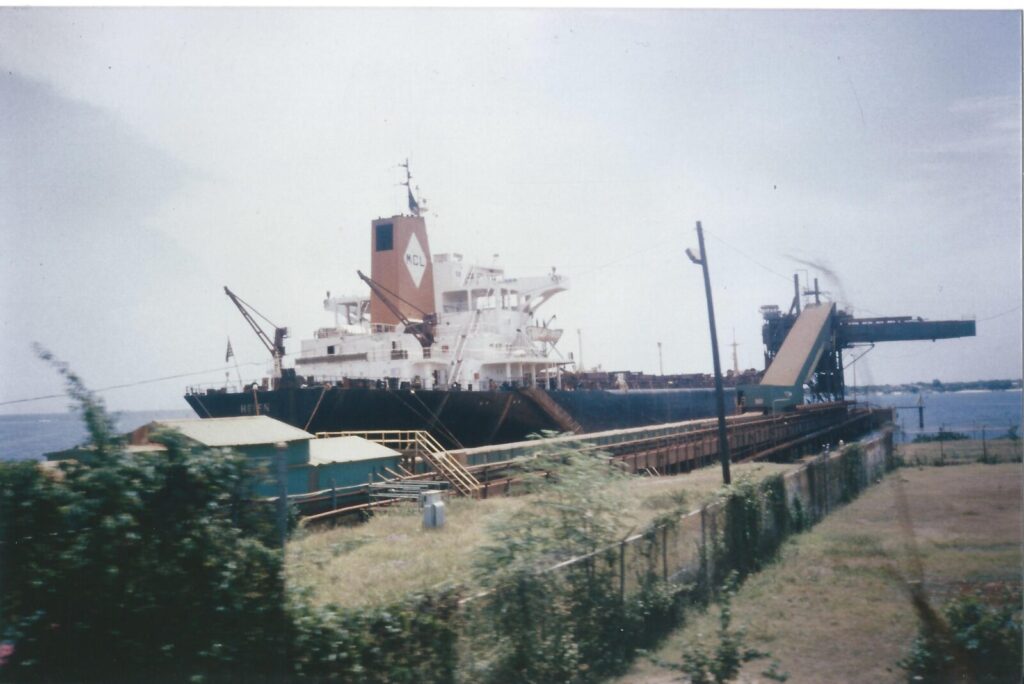
Whilst Jamaica was becoming more and more a tourist destination, it wasn’t lost on us that there were other industries on the island, just around the bay from us was the loading dock for Bauxite, the Red coloured mineral so abundant in the local hills. There had been a Bauxite mine inland of Discovery bay since the 1950’s (1952 “Reynolds”, “Kaiser” & later that year “Alcan”) and during the post war years Aluminium, produced from Bauxite, was a growth metal industry, especially so in the USA. Bauxite had definitely had an influence on the seabed local to the loading dock, we took a dive further round from the DBML and found nothing there worth looking at, we were away from the reefs admittedly, but the seabed was pretty barren
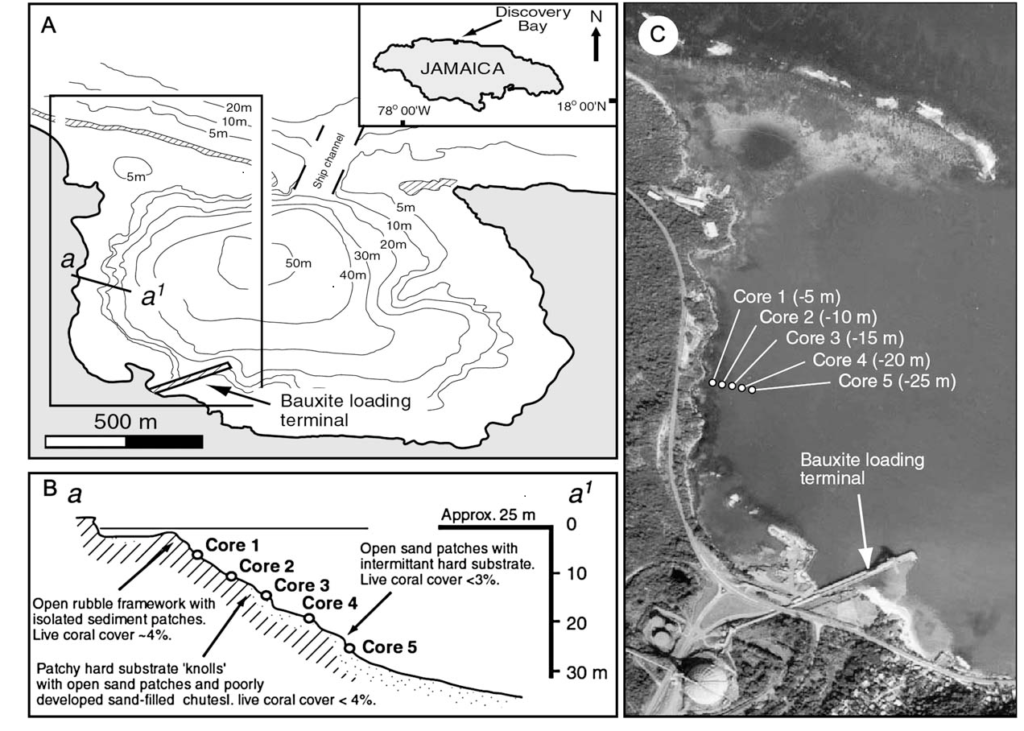
It’s easy to jump to conclusions and I’m not generally that type of person, it is coincidental that the DBML was given land by the Kaiser group, heavily invested in Bauxite production, but again, that does not mean Bauxite is particularly damaging the area beyond its own moorings. If this kind of thing interests you, then I recommend you take a look at Perry C.T and Taylor K.G “Impacts of Bauxite Sediment Inputs on a Carbonate-Dominated Embayment, Discovery Bay, Jamaica”. In the Journal of Coastal Research: Volume 20, Issue 4: pp. 1070 – 1079 (2004), where they state: “Highest contaminant levels (Fe—13,701 ppm, Mn—237 ppm, Zn—74 ppm) occur immediately adjacent to, and just north-east of, a bauxite loading terminal in the south-west of the bay” in the abstract……. Another paper by Two of those and a further contributor (Phillip Machent) of 2006 is telling, inset “B” where the core sampling is represented noting “Open rubble framework with isolated sediment patches less than 4% Live Coral Cover”. Even I can’t see high concentrations of Iron (Fe), Magnesium (Mn) and Zinc (Zn) being a good thing if I am honest…….
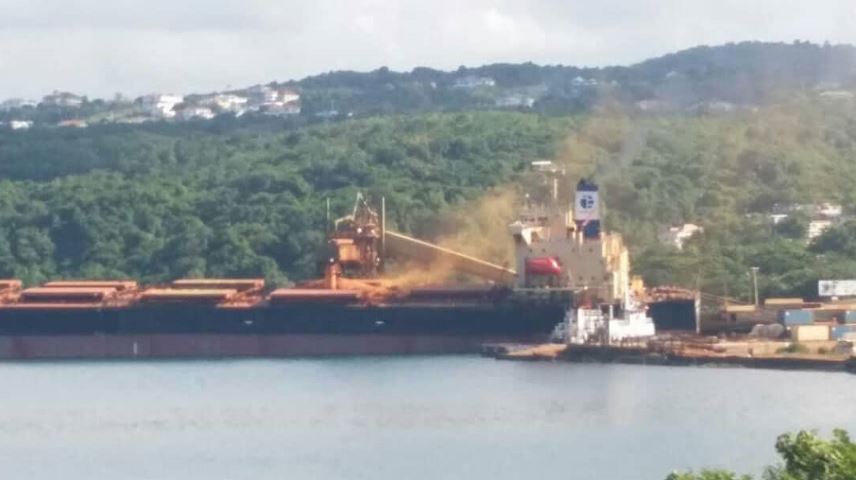
We moved back out of the confines of the bay to the outer reef wall again on the 30th June and my dive log records one of the best dives we did there: “…..Small Boat Dive – Discovery Bay (JA) Down the wall to 42m One Great Descent, couple of mins @ 42m then a slow ascent back up through the coral to 30 then a trip through the gullies & small shoals – great dive – Air in 210 out 80 W/Temp 28’ Buddy Rob” Something of an improvement on the dive to follow, where we went looking for 3 caves supposed to be in the area, not surprising in a Limestone Karst geology, but we didn’t find anything and the dive was unremarkable “….. Down around 28m to find 3 caves – No Luck – Back up to 15m for a bimble, but not so much to see….”
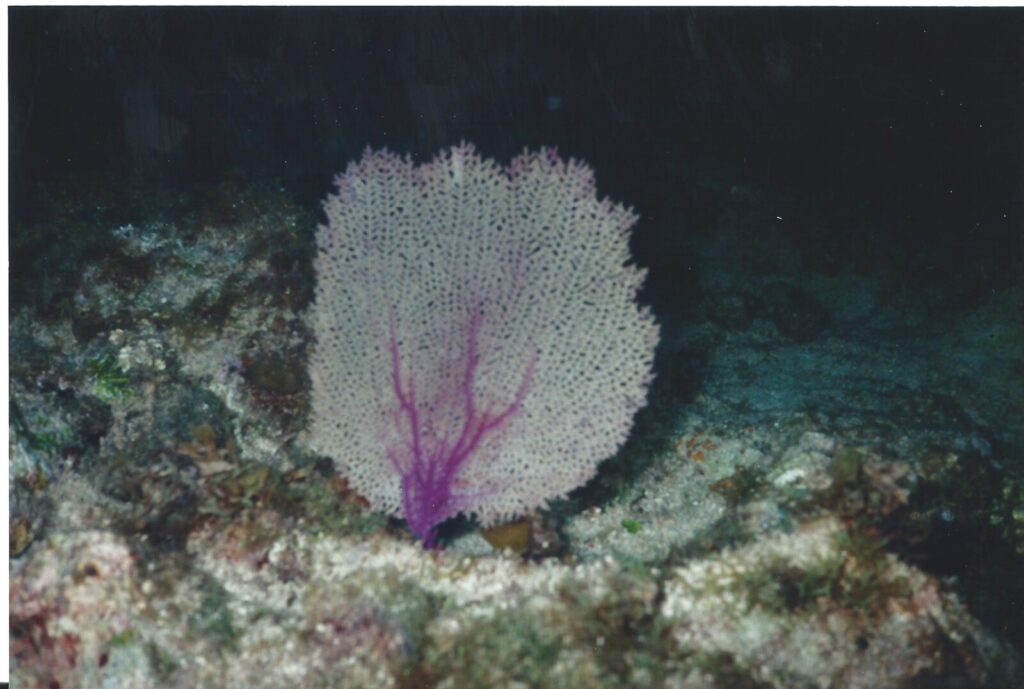
The next dive, on the same day (01st July 1994) was one of my favourites in Discovery Bay, we held back until early evening and went out for a night dive, I loved night diving by now and this one, despite coming at a personal cost, was a good one”, I’ll let the log book lead: “…..Small Boat Dive Discovery Bay (JA) Night Dive – Plenty to see Two small Leopard Rays – a huge Moray Eel – several Cuttle-Fish and Lobsters, Two Sea Snakes and various reef fish – stung by Sea Wasp Jelly – Fish on ascent but great dive, clear Star filled Sky full of Summer Lightening on return – GREAT. Air in 210 out 100 W/Temp 28’ Buddy’s Neil & Hayden” I said the dive came at a personal cost, those bloody Sea Wasp jellies hurt like hell….. I was ascending and minding my own business, just meandering up to our 3 minutes safety stop and felt like I’d been stabbed in the lip, then in the groin….nothing to see in the dark but clear water, just an agonising pain left to suck-up whilst waiting for deco to end…..bugger! You won’t know what I mean unless you get on the wrong end of one of these little Fcukers…. it was enough to bring a tear to the eyes
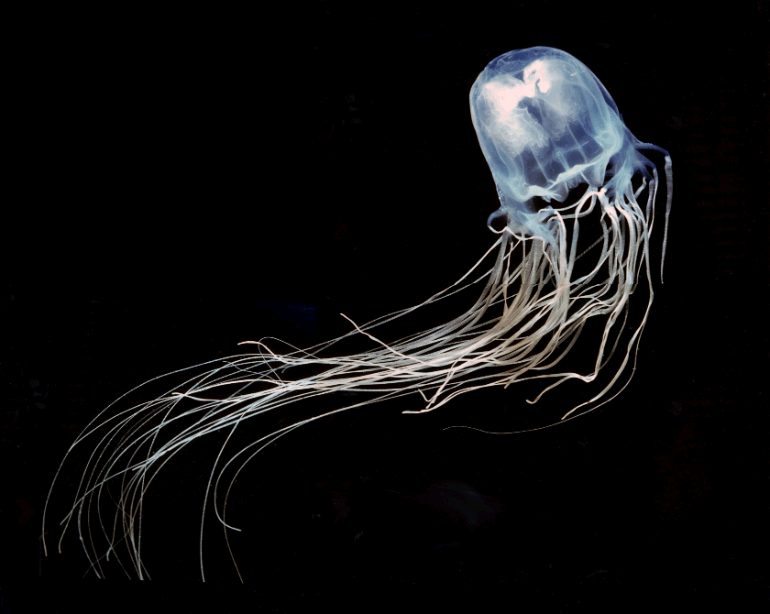
Our last dive day, 02nd July 1994 and it was going to be hard to leave, we knew the expedition was coming to an end and we wanted to go out on a memorable high, we weren’t disappointed and the log says it all: “…….Small Boat Dive – Pear Tree Bay (JA) Down to 26m for a look for the tunnels, this time we found them no problem, tied off the SMB and led through one from 17m to 20m – 15m longish full of coral – then back through after Ian – carried on for 30m or so and found another tunnel 20m long – narrow & coral filled from 17m down to 25m, tied off – led – then returned, through clouds of silt – eerie then on to 6m in the gullies to fizz off – Brilliant last dive!! Air in 200 out 60 W/Temp 28’ Buddy Ian” I loved the dive, it was everything the Caribbean could offer in terms of reef diving, the swim through’s peppered with untouched corals, fish swimming everywhere, a truly beautiful dive and a sad one too…..it was done, over, our 3 weeks in Jamaica had come to an end……….. and I was gutted
